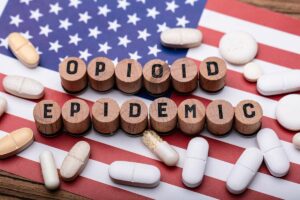- Culture
-
by Skippack Pharmacy
The Opioid Epidemic

The opioid epidemic is a multifaceted public health crisis that has been unfolding over the past several decades, particularly in the United States. It encompasses a dramatic increase in the use of both prescription and non-prescription opioid drugs, leading to widespread addiction, overdose deaths, and significant social and economic impacts.
Historical Context
The roots of the opioid epidemic can be traced back to the late 1990s when pharmaceutical companies reassured the medical community that patients would not become addicted to prescription opioid pain relievers. This led to a surge in the prescribing of these medications. However, as it became evident that these drugs were indeed highly addictive, rates of opioid misuse began to climb.
Prescription Opioids
Prescription opioids such as oxycodone, hydrocodone, and morphine are commonly used to treat moderate to severe pain. While effective for pain management, these medications have a high potential for misuse. Key factors contributing to the epidemic include:
- Over-Prescription: In the late 1990s and early 2000s, opioids were increasingly prescribed for chronic pain, leading to greater availability and misuse.
- Lack of Regulation: Initially, there was insufficient regulation and monitoring of opioid prescriptions, allowing for widespread distribution and misuse.
- Doctor Shopping: Patients seeking opioids for misuse would often visit multiple doctors to obtain more prescriptions.
Transition to Illicit Opioids
As regulations tightened and prescriptions became harder to obtain, many individuals who had developed dependencies on prescription opioids turned to illicit opioids such as heroin. Heroin is cheaper and often easier to obtain than prescription drugs. The use of heroin brought about new challenges:
- Increased Risk of Overdose: Heroin is often injected, which increases the risk of overdose and transmission of infectious diseases like HIV and hepatitis.
- Unpredictable Potency: Illicit opioids lack the consistency and quality control of prescription medications, leading to unpredictable potency and increased risk of overdose.
Synthetic Opioids
In recent years, synthetic opioids like fentanyl and its analogs have exacerbated the epidemic. Fentanyl is many times more potent than heroin and can be mixed with other drugs without the user’s knowledge, drastically increasing the likelihood of overdose. Key issues include:
- High Potency: Fentanyl is 50 to 100 times more potent than morphine, making even small amounts potentially lethal.
- Widespread Distribution: Illicitly manufactured fentanyl is often mixed with other drugs like heroin, cocaine, and methamphetamine, sometimes without the user’s knowledge, leading to unintentional overdoses.
Impact on Public Health and Society
The opioid epidemic has had profound impacts on public health and society, including:
- Overdose Deaths: According to the Centers for Disease Control and Prevention (CDC), nearly 500,000 people died from overdoses involving opioids from 1999 to 2019.
- Economic Burden: The economic impact includes healthcare costs, lost productivity, addiction treatment, and criminal justice involvement, amounting to billions of dollars annually.
- Social Consequences: Families and communities are deeply affected by the epidemic, with increases in foster care placements, criminal activity, and homelessness among those struggling with addiction.
Addressing the Epidemic
Efforts to combat the opioid epidemic involve multiple strategies, including:
- Prescription Monitoring: Implementing prescription drug monitoring programs (PDMPs) to track opioid prescriptions and identify patterns of misuse.
- Education and Prevention: Educating healthcare providers, patients, and the public about the risks of opioid use and safe prescribing practices.
- Treatment Access: Expanding access to addiction treatment services, including medication-assisted treatment (MAT) with drugs like methadone, buprenorphine, and naltrexone.
- Harm Reduction: Promoting harm reduction strategies such as needle exchange programs and the distribution of naloxone to reverse overdoses.
Conclusion
Understanding the complexity of the opioid epidemic is crucial for developing effective responses. By recognizing the historical context, the transition from prescription to illicit opioids, and the role of synthetic opioids, we can better address the ongoing crisis. Comprehensive strategies that include prevention, treatment, and harm reduction are essential to mitigating the devastating effects of the opioid epidemic.
Additional Resources:
- Van Zee A. The Promotion and Marketing of OxyContin: Commercial Triumph, Public Health Tragedy. Am J Public Health. 2009;99(2):221-227. doi:10.2105/AJPH.2007.131714.
- National Institute on Drug Abuse. Opioid Overdose Crisis. National Institutes of Health. Updated January 2020. Accessed July 24, 2024. https://www.drugabuse.gov/drug-topics/opioids/opioid-overdose-crisis
- Centers for Disease Control and Prevention. Understanding the Epidemic. Updated March 19, 2021. Accessed July 24, 2024. https://www.cdc.gov/opioids/basics/epidemic.html
- Scholl L, Seth P, Kariisa M, Wilson N, Baldwin G. Drug and Opioid-Involved Overdose Deaths — United States, 2013–2017. MMWR Morb Mortal Wkly Rep. 2019;67(5152):1419-1427. doi:10.15585/mmwr.mm675152e1.
- Volkow ND, McLellan AT. Opioid Abuse in Chronic Pain — Misconceptions and Mitigation Strategies. N Engl J Med. 2016;374(13):1253-1263. doi:10.1056/NEJMra1507771.
- Jones CM, Christensen A, Gladden RM. Increases in Synthetic Opioid Involvement in Drug Overdose Deaths in the United States, 2010–2016. MMWR Morb Mortal Wkly Rep. 2018;67(9):281-289. doi:10.15585/mmwr.mm6709e1.
- Florence CS, Zhou C, Luo F, Xu L. The Economic Burden of Prescription Opioid Overdose, Abuse, and Dependence in the United States, 2013. Med Care. 2016;54(10):901-906. doi:10.1097/MLR.0000000000000625.
- Rudd RA, Seth P, David F, Scholl L. Increases in Drug and Opioid-Involved Overdose Deaths — United States, 2010–2015. MMWR Morb Mortal Wkly Rep. 2016;65(5051):1445-1452. doi:10.15585/mmwr.mm655051e1.